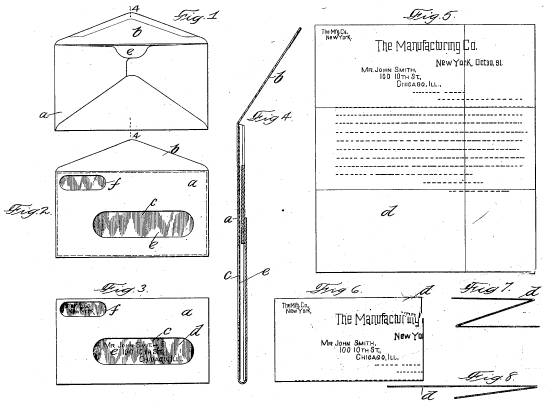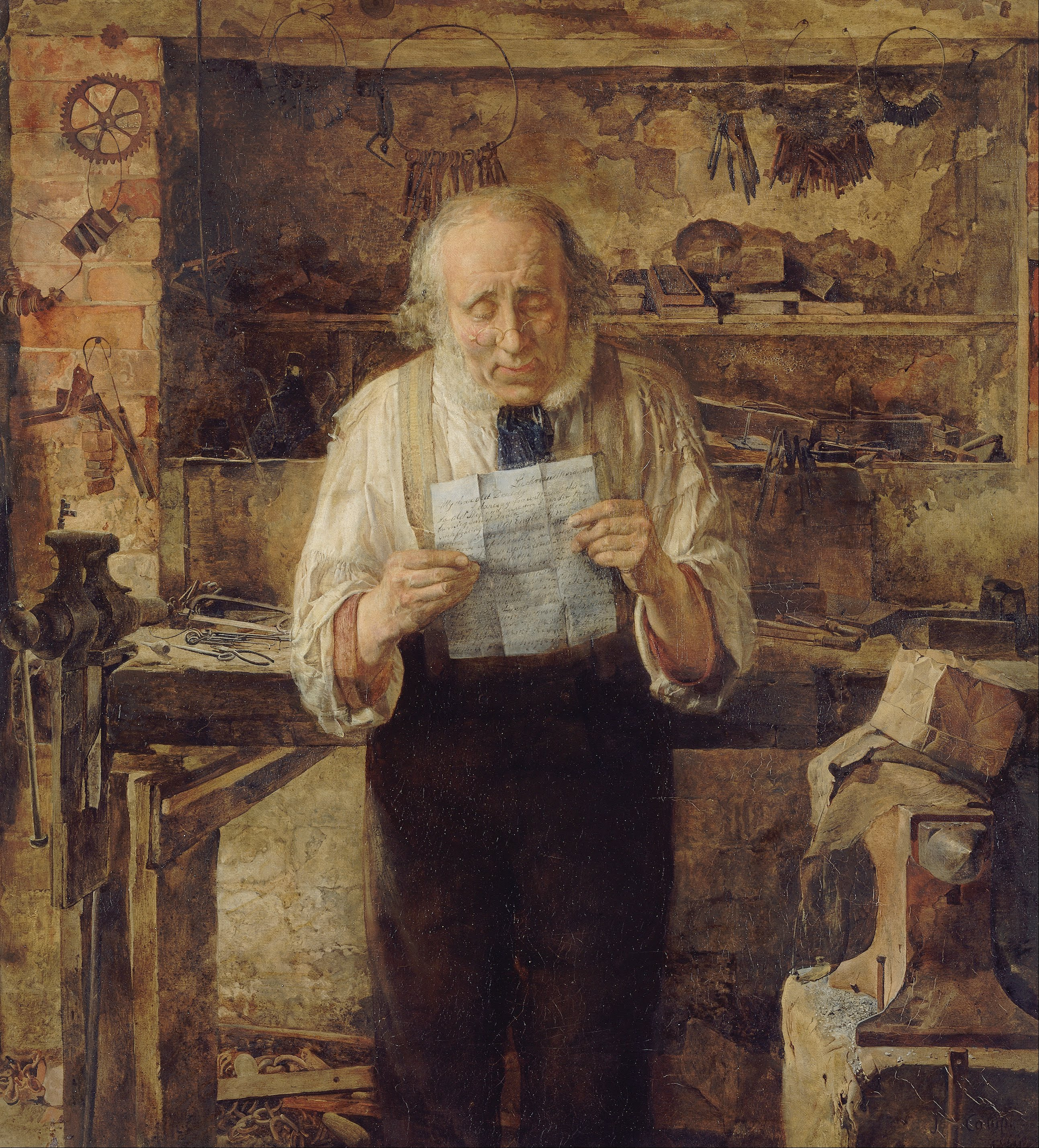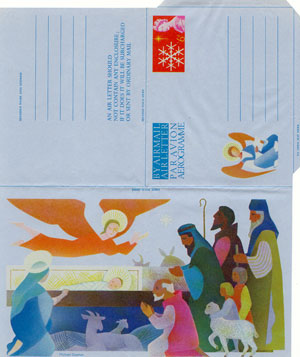|
Envelope
An envelope is a common packaging item, usually made of thin, flat material. It is designed to contain a flat object, such as a letter or card. Traditional envelopes are made from sheets of paper cut to one of three shapes: a rhombus, a short-arm cross or a kite. These shapes allow the envelope structure to be made by folding the sheet sides around a central rectangular area. In this manner, a rectangle-faced enclosure is formed with an arrangement of four flaps on the reverse side. Overview A folding sequence such that the last flap closed is on a short side is referred to in commercial envelope manufacture as a pocket – a format frequently employed in the packaging of small quantities of seeds. Although in principle the flaps can be held in place by securing the topmost flap at a single point (for example with a wax seal), generally they are pasted or gummed together at the overlaps. They are most commonly used for enclosing and sending mail (letters) through a prepaid- ... [...More Info...] [...Related Items...] OR: [Wikipedia] [Google] [Baidu] |
Letterlocking
Letterlocking is the act of folding and securing a written message (such as a letter) on papyrus, parchment, or paper, without requiring it to be contained in an envelope or packet. It is a traditional method of document security that utilizes folding and cutting. The process dates to the 13th century in Western history, corresponding with the availability of flexible writing paper. Letterlocking uses small slits, tabs, and holes placed directly into a letter, which combined with folding techniques are used to secure the letter ("letterpacket"), preventing reading the letter without breaking seals or slips, providing a means of tamper resistance and tamper evidence. These folds and holes may be additionally secured with string and sealing wax. A particularly intricate method known as a spiral lock was in use by people of many social backgrounds in early modern Europe, including monarchs Mary Queen of Scots and Elizabeth I of England. The pages of a letter would be folded together ... [...More Info...] [...Related Items...] OR: [Wikipedia] [Google] [Baidu] |
Mulready Stationery
Mulready stationery describes the postal stationery letter sheets and envelopes that were introduced as part of the British Post Office postal reforms of 1840. They went on sale on 1 May 1840, and were valid for use from 6 May. The Mulready name arises from the fact that William Mulready, a well-known artist of the time, was commissioned to illustrate the part of the letter sheets and envelopes which corresponded with the face area. Design The design incorporated a munificent Britannia at the centre top with a shield and a reclining lion surrounded on either side by a representation of the continents of Asia and North America with people reading their mail in the two lower corners, bestowing the benefits of mail services to the countries of the world under British control. The Mulready illustration, engraved by John Thompson, was printed such that it appeared on the face of the sheets when folded. The Mulready letter sheets followed the traditional letter sheet design and could b ... [...More Info...] [...Related Items...] OR: [Wikipedia] [Google] [Baidu] |
Letter Sheet
In philatelic terminology a letter sheet, often written lettersheet, is a sheet of paper that can be folded, usually sealed (most often with sealing wax in the 18th and 19th centuries), and mailed without the use of an envelope, or it can also be a similar item of postal stationery issued by a postal authority. Letter sheets derive from the form in which written correspondence was made up before the mid-19th century — letters were written on one or more sheets of paper that were folded and sealed in such a way that the address could be written on the outside. The term lettersheet has been used to describe the unstamped folded sheet letters used before envelopes became popular. Recent academic research and conservation initiatives have termed such folded and sealed letters as "letterpackets”; however, only a relatively small number of early examples, such as the Brienne Collection (1689–1706) at The Hague, are known to exist. Envelopes were not used much before the sec ... [...More Info...] [...Related Items...] OR: [Wikipedia] [Google] [Baidu] |
Americus Callahan
A windowed envelope is a conventional envelope with a plastic (typically film or BOPS Bi-oriented polystyrene films) window to allow the recipient's address to be printed on the paper contained within. History Americus F. Callahan of Chicago, Illinois, in the United States, received the first patent for a windowed envelope on 10 June 1902. Originally called the "outlook envelop", the patent initially anticipated using thin rice paper as the transparent material forming the window, though this material has since been replaced by clear plastics. The design has otherwise remained nearly unchanged. The design and patent letter were completed on 15 November 1901, with the patent filing occurring on 9 December 1901. The United States patent number for Callahan's design is 701,839. Callahan specifically recommended the use of Manila paper, which is considerably cheaper than thicker writing paper and also provides an opaque background for secure covering of the letter within. Call ... [...More Info...] [...Related Items...] OR: [Wikipedia] [Google] [Baidu] |
Letter (message)
A letter is a written message conveyed from one person (or group of people) to another through a medium. Something epistolary means that it is a form of letter writing. The term usually excludes written material intended to be read in its original form by large numbers of people, such as newspapers and placards, although even these may include material in the form of an "open letter". The typical form of a letter for many centuries, and the archetypal concept even today, is a sheet (or several sheets) of paper that is sent to a correspondent through a postal system. A letter can be formal or informal, depending on its audience and purpose. Besides being a means of communication and a store of information, letter writing has played a role in the reproduction of writing as an art throughout history. Letters have been sent since antiquity and are mentioned in the ''Iliad''. Historians Herodotus and Thucydides mention and use letters in their writings. History of letter writing Hi ... [...More Info...] [...Related Items...] OR: [Wikipedia] [Google] [Baidu] |
Cover (philately)
In philately, the term cover pertains to the outside of an envelope or Mail, package with an address, typically with postage stamps that have been Cancellation (mail), cancelled and is a term generally used among stamp and postal history collectors. The term does not include the contents of the letter or package, although they may add interest to the item if still present. Cover collecting plays an important role in postal history as many covers bear stamps, postmarks and other markings along with names and addresses all of which help to place a cover at a given time and place in history. History The term originates from the practice of covering a letter by folding a separate sheet about it to physically protect it and prevent infringement of confidentiality. In the first half of the 19th century it became the fashion to cut the cover into a diamond or lozenge shape. This was the precursor of the version of the envelope known today. Its convenience and popularity led to the lozen ... [...More Info...] [...Related Items...] OR: [Wikipedia] [Google] [Baidu] |
Aerogram
An aerogram, aerogramme, aérogramme, air letter or airletter is a thin lightweight piece of foldable and gummed paper for writing a letter for transit via airmail, in which the letter and envelope are one and the same. Most postal administrations forbid enclosures in these light letters, which are usually sent abroad at a preferential rate. Printed warnings existed to say that an enclosure would cause the mail to go at the higher letter rate. The use of the term ''aerogramme'' was officially endorsed at the 1952 Universal Postal Union Postal Union Congress in Brussels."The Evolution of the Postal Service in the Era of the UPU" by Jamie Gough in ''The London Philatelist'', Vol.114, No. 1331, December 2005, pp.362-363. Thereafter, the term ''air letter'' quickly faded from use. Most aerograms have an imprinted stamp indicating the prepayment of postage. As such, this meets the definition of being postal stationery. However, some countries such as New Zealand, Zimbabwe and Irel ... [...More Info...] [...Related Items...] OR: [Wikipedia] [Google] [Baidu] |
Metered Reply Mail
Metered reply mail, or MRM, is a type of mail in which a business sends pre-printed, self-addressed envelopes or postcards to customers, with postage prepaid on the envelopes or postcards with a postage meter. It is thus similar to courtesy reply mail with a postage stamp already affixed. Metered reply mail differs from business reply mail in the manner of payment of postage, namely, by the postage meter indicating when the mail is sent, rather than by the permit holder when the mail is received. In the United States, the United States Postal Service The United States Postal Service (USPS), also known as the Post Office, U.S. Mail, or Postal Service, is an independent agency of the executive branch of the United States federal government responsible for providing postal service in the U ... specifies that the envelopes or postcards for metered reply mail should be printed with a FIM A code. See also * Self-addressed stamped envelope References Postal systems Philat ... [...More Info...] [...Related Items...] OR: [Wikipedia] [Google] [Baidu] |
Confederate States Army
The Confederate States Army, also called the Confederate Army or the Southern Army, was the military land force of the Confederate States of America (commonly referred to as the Confederacy) during the American Civil War (1861–1865), fighting against the United States forces to win the independence of the Southern states and uphold the institution of slavery. On February 28, 1861, the Provisional Confederate Congress established a provisional volunteer army and gave control over military operations and authority for mustering state forces and volunteers to the newly chosen Confederate president, Jefferson Davis. Davis was a graduate of the U.S. Military Academy, and colonel of a volunteer regiment during the Mexican–American War. He had also been a United States senator from Mississippi and U.S. Secretary of War under President Franklin Pierce. On March 1, 1861, on behalf of the Confederate government, Davis assumed control of the military situation at Charleston, South C ... [...More Info...] [...Related Items...] OR: [Wikipedia] [Google] [Baidu] |
National Postal Museum
The National Postal Museum, located opposite Union Station in Washington, D.C., United States, covers large portions of the Postal history of the United States and other countries. It was established through joint agreement between the United States Postal Service and the Smithsonian Institution and opened in 1993. Premises The museum is located across the street from Union Station, in the building that served as the main post office of Washington, D.C. for decades, from its construction in 1914 until 1986. The building was designed by the Graham and Burnham architectural firm, which was led by Ernest Graham following the death of Daniel Burnham in 1912. The headquarters of the United States Department of Labor's Bureau of Labor Statistics is based in this building, and there is also space for a data center for the United States Senate. Displays The museum holds the National Philatelic Collection. It has hosted many interactive displays about the history of the United Stat ... [...More Info...] [...Related Items...] OR: [Wikipedia] [Google] [Baidu] |
Freepost
Freepost is a postal service provided by various postal administrations, whereby a person sends mail without affixing postage, and the recipient pays the postage when collecting the mail. Freepost differs from self-addressed stamped envelopes, courtesy reply mail, and metered reply mail in that the recipient of the freepost pays only for those items that are actually received, rather than for all that are distributed. Freepost of preprinted cards issued by businesses is also different from postal stationery sold by postal administrations. Uses In one use of freepost, a business sends bulk mail to potential customers, the bulk mail including envelopes or postcards that potential customers can return to the business by freepost. In another use, magazines include subscription cards that potential subscribers can return by freepost. In another use, a seller can provide a merchandise return label bearing the appropriate freepost indicia (as described below) to a customer so th ... [...More Info...] [...Related Items...] OR: [Wikipedia] [Google] [Baidu] |
Rowland Hill (postal Reformer)
Sir Rowland Hill, KCB, FRS (3 December 1795 – 27 August 1879) was an English teacher, inventor and social reformer. He campaigned for a comprehensive reform of the postal system, based on the concept of Uniform Penny Post and his solution of pre-payment, facilitating the safe, speedy and cheap transfer of letters. Hill later served as a government postal official, and he is usually credited with originating the basic concepts of the modern postal service, including the invention of the postage stamp. Hill made the case that if letters were cheaper to send, people, including the poorer classes, would send more of them, thus eventually profits would go up. Proposing an adhesive stamp to indicate pre-payment of postage – with the first being the Penny Black – in 1840, the first year of Penny Post, the number of letters sent in the UK more than doubled. Within 10 years, it had doubled again. Within three years postage stamps were introduced in Switzerland and Brazil, a ... [...More Info...] [...Related Items...] OR: [Wikipedia] [Google] [Baidu] |






.jpg)
_Weld_Taylor%2C_printed_by_Hullmandel_&_Walton%2C_published_by_Joseph_Hogarth.jpg)